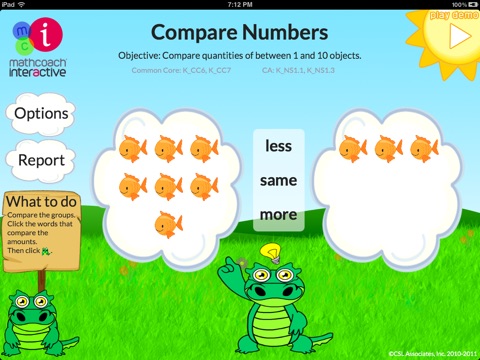
From CSL Associates, Inc., a trusted provider of effective math curriculum since 1999.
Make sure that your child is ready for first grade with this thorough review of number skills, fine motor skills, listening skills, and patience he or she needs to be a successful first grader.
POLISH UP THOSE ESSENTIAL EARLY MATH SKILLS
Did you know that early math skills are the most reliable predictor of later academic success? Read about the university study at http://www.uci.edu/features/2011/04/feature_duncan_110427.php]
Essential early math skills include connecting number names to quantities, looking and listening for patterns, and comparing objects in different ways (by size, number, color, shape, and logical grouping). KinderMath engages your child to develop these skills with sight, sound, and touch.
FOUR FEATURED ACTIVITIES BUILD UNDERSTANDING
Show This Many (Common Core: KCC.4, KCC.5)
Sort, Classify, Count (Common Core: KMD.3)
Count On From Any Number (Common Core: KCC.2)
Compare Numbers (Common Core: KCC.6, KCC.7)
MORE ABOUT EARLY MATH SKILLS
Show This Many
Many children learn number words but don’t know what they mean. This activity helps you make sure that your child can see and understand the amount counted when we say a number. The ten frame models for 10 and 20 help your child keep track of counting. With ten frames children also intuitively see that one number is made up of smaller numbers. When children can see numbers within a number, they are better prepared to add and subtract.
Sort, Classify, Count
Engage children to sort pictures by different categories (size, color, shape, attribute). The audio names each object to reinforce language development. As children sort, the pictures move into a graph. Children then answer questions related to the data they collected in the graph.
Count On From Any Number
Children hear a number and then show how many with tenframes. Then they say the next three numbers. This is called “counting on.” As children count on, the model changes to show each new number. In this way children see that counting on means “one more” and discover auditory and visual number patterns.
Compare Numbers
Children begin at the concrete level to compare groups of objects and determine which has more, which has less, and which groups show the same amount. Children can tap on each group to hear each number. For advanced learners, levels C and D challenge children to listen and compare numbers greater than 20, using mathematical symbols for “more than”, “less than”, and “equal to.”
Check out our web site at www.mathcoachinteractive.com.



